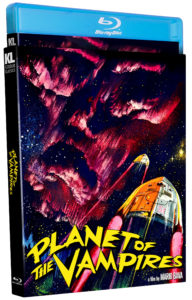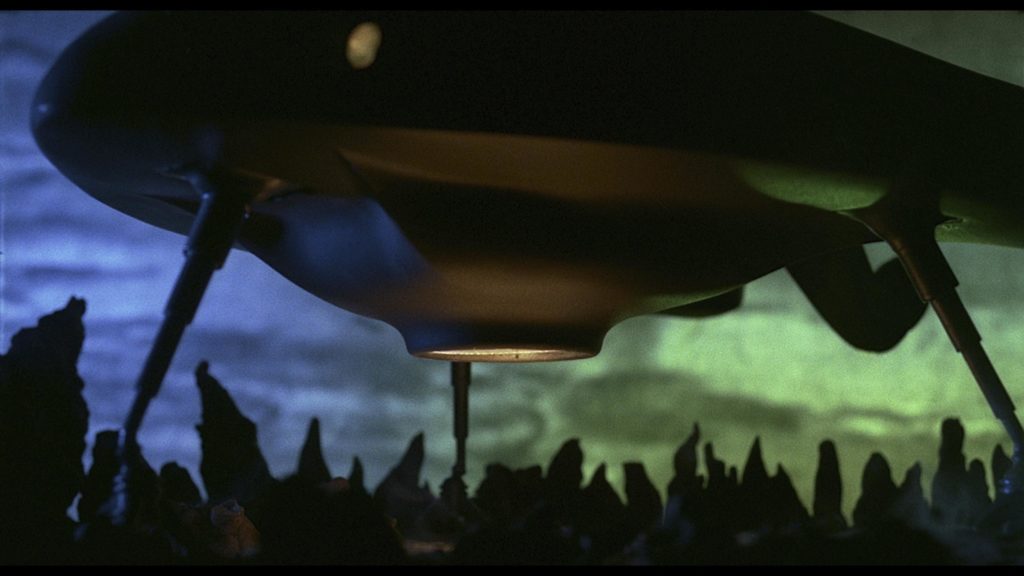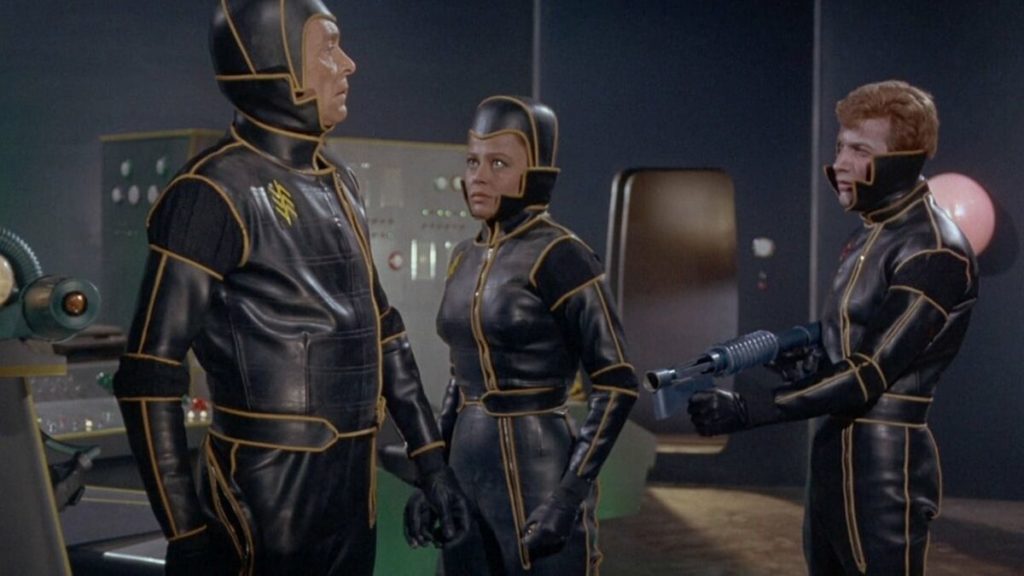Mario Bava Takes his Saturated Nightmares to Outer Space with Sci-Fi/Horror Classic
DIRECTED BY MARIO BAVA/1965
BLU-RAY STREET DATE: JULY 26, 2022/KL STUDIO CLASSICS
ZekeFilm remembers and honors Donna Lucas, the recently departed wife and guiding light of Tim Lucas, Bava historian extraordinaire.
*****

“They’re vampires, Captain, but not as we know them.”
The above line is uttered by absolutely no one throughout Mario Bava’s innovative and venerable and space-horror picture, Planet of the Vampires (Terrore nello Spazio or, Terror in Space, to list just one of its alternate titles). If it were, it would simply be yet another way in which this studio-bound (at Italy’s historic Cinecitta, no less) production paved the way for Gene Roddenberry’s Star Trek. Slotting in between the September 1966 premiere of that iconic series and the 1956 heyday of its unofficial predecessor, MGM’s lavish Forbidden Planet, Bava’s ominous tale of planetary exploration gone wrong, bears all of the tidy uniformed militaristic outfitting of both.
Previously released to Blu-ray by Kino Lorber in 2014, the company has since returned to Planet of the Vampires, presenting it once again in 1080p, but with a new beautiful 2K transfer and restoration. Without having seen this Italian-Spanish production (made with the backing of American International Pictures) in any previous incarnation, I can confidently report that this Blu-ray stands as the most visually effectively Bava-esque Mario Bava film to ever grace my home theater. (And there’ve been many). Adorned in fog and dark magenta ambience shot at jarring angles, the desolate surface of the apparently uninhabited planet Aura is the very epitome of absorptive immersion. It’s nothing but fake rock formations, model spacecraft, and all manner of in-camera practical forced perspectives. It not only works so much better than it has any right to, but it is also what sustains Planet of the Vampires and makes it outstanding.

That Planet of the Vampires’ effects and eeriness all but single-handedly elevates the film to the level of prime Bava (no small feat) is outstanding in itself. Very little else of the film stands out in any way. That is, aside from the subsequent unavoidable connect-the-dots that reveals Ridley Scott’s Alien something of a blatant rip. Though Scott has gone on record claiming never to have seen Planet of the Vampires, the carefully cultivated mood of angular dread on the unnamed moon where the Nostromo crew first picks up their unwanted guest suggests otherwise. The discovery of oversized spacefaring victims of the titular threat- Alien’s murdered “space jockey”- virtually confirms that at the very least, that screenwriter Dan O’Bannon definitely was, at best, strongly influenced by Bava’s film.
Despite Planet of the Vampires’ own narrative shortcomings, Alien should not be what it’s remembered for. Opting to respond to a distress call from an unexplored heavenly body which results in the fatal derailing of the crew’s otherwise mundane space mission is a big similarity, as is much of what follows. But the threat- the so-called “vampires”- couldn’t be further from the big toothy grotesque xenomorph that stalks Ripley and company. Bava’s creatures, ghosts of the dead planetary natives, reside purely as optical effects. That is, until they “possess” members of the human crew, reducing them to id-driven violent zombie-types. The best of the crew struggle mightily to overcome the supernatural cosmic control, but one by one, many succumb.

Before the landing, it such an ideally dull flight. The crew members of the Argos and its partner vessel, the Galliott, all adorned in high-collared tight-fitting black leather ala the early X-Men movies, each dutifully work at their stations in the ships’ oversized reflective control center. If they don’t seem to communicate terribly effectively with one another, there’s a reason for that. This being a multinational production in every sense, and filmed in Italy when everything was post-synched, the on-camera talent spoke in their own native tongues, and that was that. While this practice was absolutely common in Italy at the time (“Hollywood on the Tiber”), the Babel-esque method makes for some very stilted relations among the supposedly tightknit crew of the Argos.
What about the crew of the Galliott? Well… it gets separated from the Argos in the descent, and immediately goes unresponsive. The Argos crew, led by the Wahlberg-ian named Captain Mark Markary (a fifty-plus year-old Barry Sullivan, whom we’re told Bava did not want but AIP insisted upon), must first work free of its own violent bout of sudden-onset mysterious possession. (Other prominent crew members are played by Norma Bengell, Evi Marandi, Ángel Aranda, Ivan Rassimov). There’s an undeniable stilted quality about the whole thing. That paired with the screenplay’s murky but ambitious scope on a budget of only $200,000 makes for a challenging potboiler that only Bava and few others could forge into something memorable.
Most of the extras from Kino’s 2014 edition remain, with minor variances. While the text screens of the original short story which this film is based upon and the stills gallery have been dropped, we gain a new commentary track featuring the great horror historian Kim Newman and Barry Forshaw. Newman and Forshaw, in a lively and loose discussion, cover a lot of ground, particularly around the aforementioned pop culture touchstones surrounding Planet of the Vampires. They are mindful not to duplicate a lot of Mario Bava historian and author Tim Lucas’ quieter 2014 track, which focuses more exclusively on Bava, his techniques, the actors, and the production itself. Both commentaries are well worth a fan’s time, though they couldn’t be more stylistically different.

Beyond the commentaries, we get two Trailers from Hell segments that, in the span of the film’s trailer, offer quick analysis of the film proper. One is by Joe Dante and the other by Josh Olson. For the completionists and curious alike, there is also a very brief Italian opening titles segment. Also, there’s the American trailer proper. There is also an alternate Italian soundtrack which also highlights twenty or so minutes of Gino Marinuzzi, Jr.’s excellent atmospheric, electronic score. For anyone who really misses the 2014 edition’s cover art, all you need to do is reverse the insert, and viola. The new slipcover, however, remains the revised cover art at all times.
Not particularly scary though thoroughly nightmarish, the various contrivances (That Twilight Zone ending! Does not make sense). and flat characters keeps Planet of the Vampires from soaring beyond its rarified realm of top Bava. That said, the film’s legacy, as it’s been cherry-picked by some of the best, solidifies its place in the sci-fi pop culture canon. The new disc is a beautiful testament to Bava’s visual and effects artistry and is well worth exploring.

